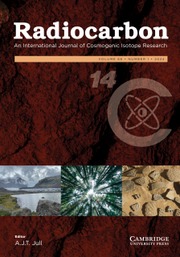No CrossRef data available.
Article contents
IMPROVING IONPLUS MICADAS PERFORMANCE WITH RECESSED GRAPHITE
Published online by Cambridge University Press: 04 April 2024
Abstract
Cathodes with recessed sample surfaces have several benefits in cesium sputter ion sources, including higher output, more efficient use of sample material, and improved focusing of the extracted ion beam. However, the Ionplus MICADAS uses cathodes with a graphite surface that is essentially flush with the sample holder. To evaluate the performance of recessed graphite with the MICADAS and determine the optimal surface depth, we tested four different depths, including the standard (flush) pressing method, 0.5 mm, 1.0 mm, and 1.5 mm. We found that recessed depths of 1.0 and 1.5 mm resulted in 20% higher ion beam current compared to the standard method under the same source conditions. The results are consistent with the beam produced from the recessed targets being more narrowly focused with a lower emittance, resulting in better transmission through the accelerator. Small graphite samples (200 µg C) with recessed surfaces produced higher currents for longer, leading to a 2–3× increase in sample ionization efficiency. Additionally, there was some evidence that isotopic ratio measurements of recessed samples were more stable over time. Overall, samples recessed to 1 mm depth offered numerous advantages over the standard pressing method and we have subsequently started pressing all MICADAS graphite using this approach.
Keywords
- Type
- Conference Paper
- Information
- Radiocarbon , Volume 66 , Issue 5: 24th Radiocarbon and 10th 14C & Archaeology, Zurich, Sept. 11–16, 2022 Proceedings Part 1 of 2 , October 2024 , pp. 1460 - 1468
- Copyright
- © Woods Hole Oceanographic Institution, 2024. Published by Cambridge University Press on behalf of University of Arizona
Footnotes
Selected Papers from the 24th Radiocarbon and 10th Radiocarbon & Archaeology International Conferences, Zurich, Switzerland, 11–16 Sept. 2022.



